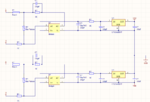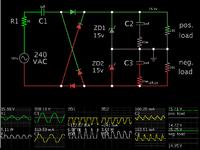bmandl
Full Member level 4
Hello,
I need some low current power supply for my project with opamps, that need dual power supply. Is it possible, to make such supply with two capacitive power supplys? Would this design, that I drew work? Do I need negative voltage regulator on bottom line, or is it good as it is?
PS.: don't mind capacitor and resistors values, I didn't determined them yet.

I need some low current power supply for my project with opamps, that need dual power supply. Is it possible, to make such supply with two capacitive power supplys? Would this design, that I drew work? Do I need negative voltage regulator on bottom line, or is it good as it is?
PS.: don't mind capacitor and resistors values, I didn't determined them yet.




